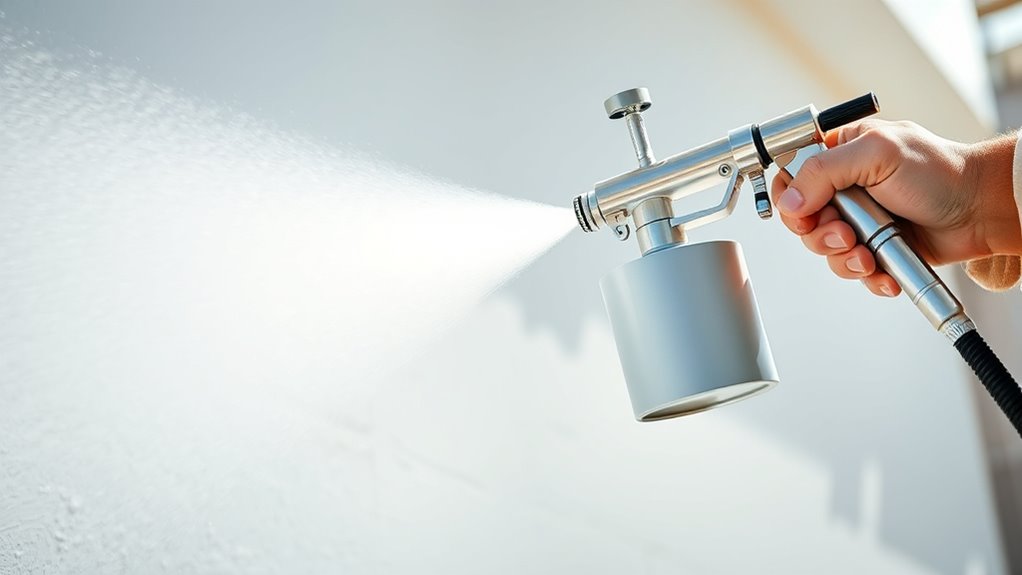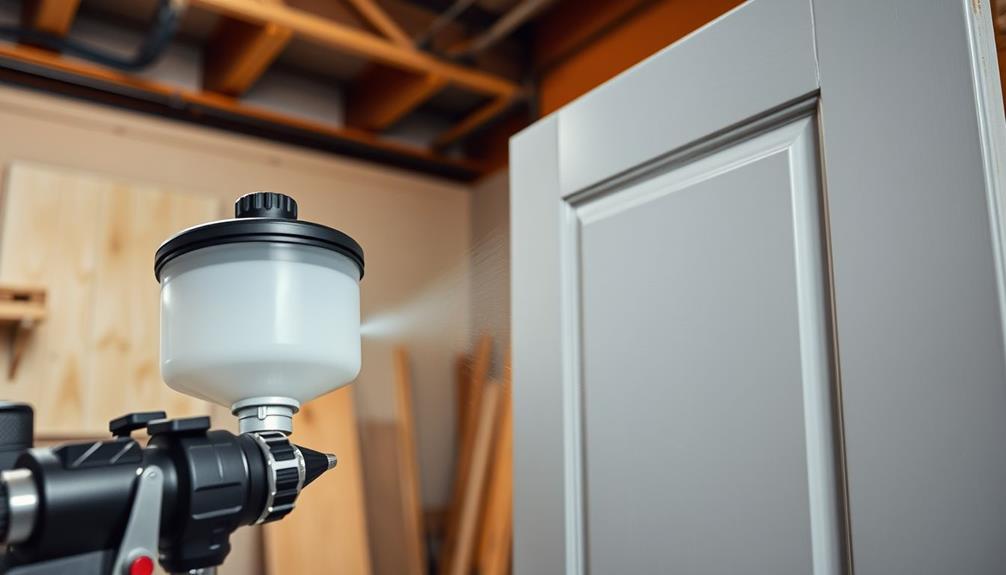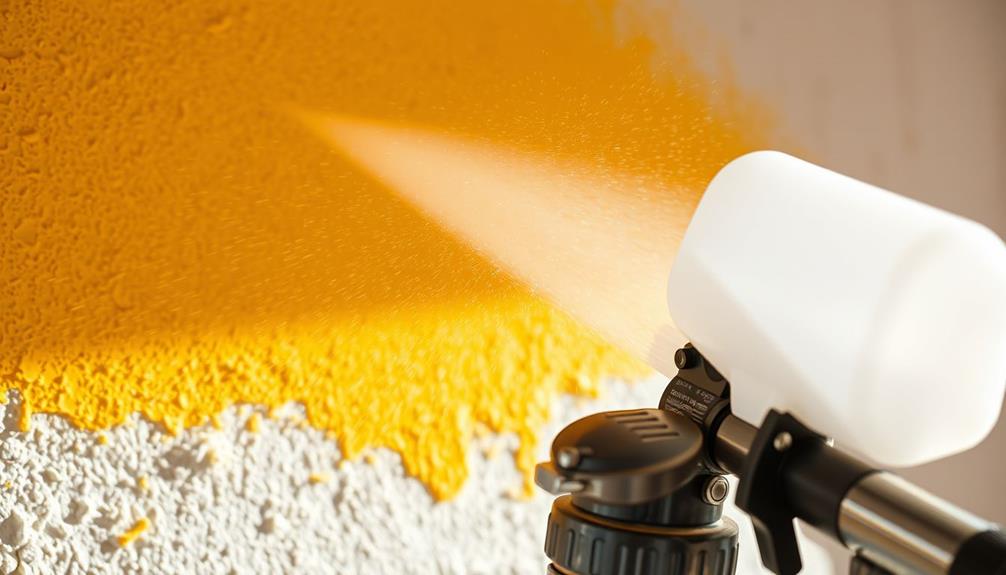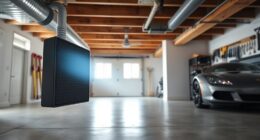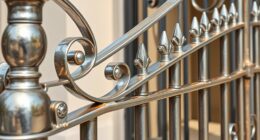Painting with an airless sprayer is typically two to four times faster than using brushes or rollers, allowing you to cover large surfaces quickly and efficiently. It minimizes your painting time, reduces fatigue, and guarantees even coverage with less effort. Proper setup and technique can boost your speed even more. If you want to discover tips for maximizing your efficiency and making the most of this powerful tool, stay tuned for more insights.
Key Takeaways
- Airless sprayers can cover 200-300 sq ft/hour, doubling or tripling the speed of brushes or rollers.
- They significantly reduce painting time for large surfaces, completing projects in a fraction of the traditional time.
- Proper setup and technique maximize coverage, further accelerating the painting process.
- Speed gains depend on surface smoothness, paint viscosity, and equipment maintenance, optimizing application rates.
- Overall, airless sprayers can finish large projects 2-3 times faster than manual methods.
Time Comparison: Airless Sprayer vs. Traditional Brushes and Rollers

When it comes to painting efficiently, an airless sprayer considerably outpaces traditional brushes and rollers regarding speed. You can cover large surfaces quickly, saving time on labor. During paint color selection, the sprayer reduces the need for multiple coats, especially with compatible paints, further speeding up the process. Environmental considerations also favor sprayers; they minimize paint waste compared to brushes and rollers, which often absorb excess paint. Plus, a sprayer’s even application reduces the need for touch-ups, cutting down overall project time. While traditional tools require more manual effort and multiple passes, an airless sprayer delivers consistent coverage faster, allowing you to complete projects in a fraction of the time. This efficiency makes it ideal for large-scale or time-sensitive painting tasks. Additionally, using an airless sprayer can help preserve the integrity of paint formulation, ensuring optimal adhesion and durability.
Factors Influencing Painting Speed With an Airless Sprayer

Several factors can considerably impact how quickly you can complete a painting project with an airless sprayer. Proper paint preparation is essential; thinning paint and ensuring it’s free of debris helps the sprayer operate smoothly and reduces clogging, speeding up the process. Equally important is equipment maintenance—regularly cleaning filters, replacing worn parts, and checking nozzles prevent downtime. If your equipment is well-maintained, you’ll experience fewer interruptions and more consistent spray patterns. Additionally, adjusting pressure settings and controlling your spray technique can improve efficiency. Neglecting these factors often leads to slower work, uneven finishes, or equipment failures. Ensuring proper filtration and pump protection plays a critical role in maintaining optimal spray gun performance and avoiding costly repairs. By prioritizing thorough paint preparation and ongoing equipment maintenance, you set yourself up for a faster, more effective painting experience.
Average Coverage Rates for Airless Sprayers
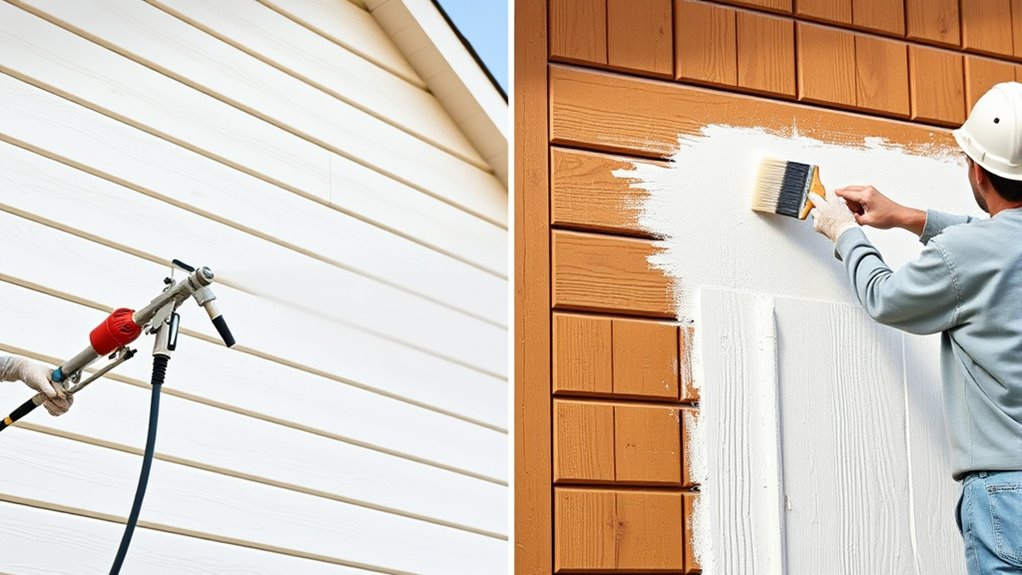
Understanding the average coverage rates of airless sprayers helps you plan your projects more accurately. Typically, airless sprayers cover about 200 to 300 square feet per hour, depending on the paint type and spray equipment. This rate is markedly faster than traditional brush techniques or roller types, which usually cover 100 to 150 square feet hourly. Your choice of roller types impacts coverage as well; thicker nap rollers may require more passes, reducing efficiency. When comparing coverage, consider that sprayers deliver a more uniform coat quickly, saving you time. However, mastering proper spray techniques is essential to maximize coverage and minimize waste. Proper tuning of your spray equipment can further enhance efficiency and paint application quality. Knowing these rates helps you estimate project timelines and allocate resources effectively.
Impact of Surface Type and Condition on Application Speed
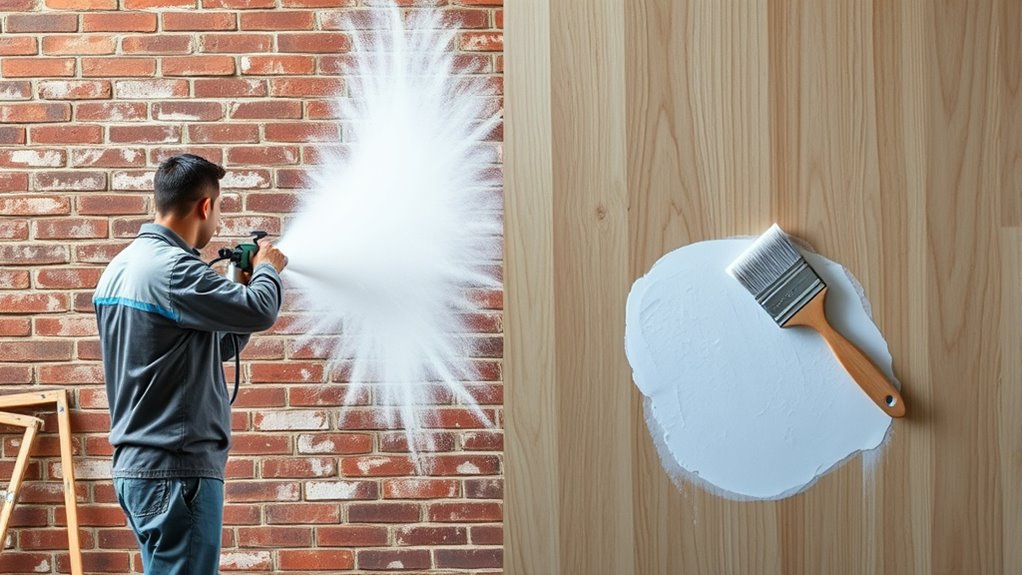
The type and condition of the surface you’re spraying directly influence how quickly and effectively you can apply paint. Proper surface preparation ensures a smooth, clean surface, reducing the need for multiple coats and speeding up your project. Rough or textured surfaces may require more passes, slowing down application, while smooth surfaces allow for faster coverage. Additionally, paint viscosity plays a vital role; thicker paints can clog the sprayer or require thinning, which affects spraying speed. If the paint is too viscous, you’ll spend extra time adjusting equipment or reworking areas, reducing overall efficiency. Well-prepared surfaces and appropriately thinned paint enable the airless sprayer to operate at maximum speed, delivering even coverage without unnecessary stops or slowdowns. Surface quality also impacts how smoothly the sprayer can operate and influence overall application speed.
Setting Up and Takedown Time for Airless Sprayers
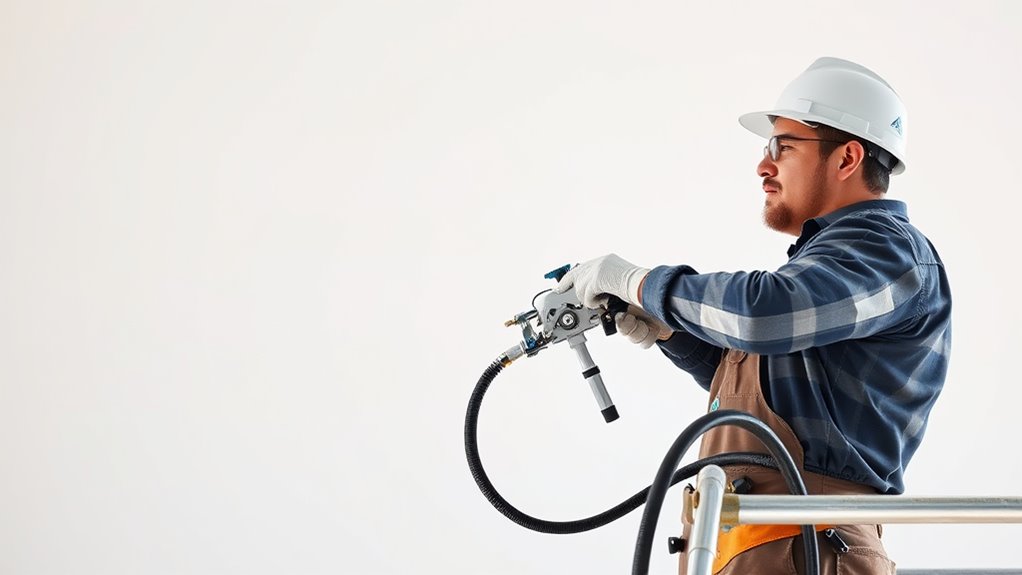
Setting up and takedown are essential steps that can greatly impact your overall painting speed with an airless sprayer. Efficient setup involves preparing the equipment, attaching the spray gun, and adjusting pressure settings quickly. Proper cleaning process routines during takedown help prevent clogs and paint buildup, reducing downtime later. Streamlining equipment maintenance, like inspecting hoses and filters after each use, ensures the sprayer works smoothly for your next project. Quick disassembly and cleaning save time and keep your equipment in top condition. Investing a little effort into these steps pays off by minimizing delays, so you can get back to painting faster. Overall, effective setup and takedown are key to maximizing your productivity with an airless sprayer. Additionally, familiarizing yourself with maintenance tips can help ensure consistent performance over time.
Skill Level and Technique: Maximizing Speed With an Airless Sprayer

To maximize your speed with an airless sprayer, honing your technique and developing your skills are essential. Proper brush techniques, like maintaining a consistent distance and smooth motion, help you avoid uneven coverage and reduce rework. Understanding paint viscosity is equally important; thinner paint flows more easily and sprays evenly, increasing efficiency. If the paint is too thick, it can clog the nozzle, slowing you down and causing frustration. Practice controlling your spray pattern and speed to achieve consistent coverage, minimizing overlaps and drips. With experienced technique, you’ll apply paint more evenly and quickly, reducing the need for touch-ups. Improving your skills ensures you’re making the most of your equipment, ultimately saving time on each project. Additionally, understanding the Power of Imagination can inspire innovative approaches to your project, leading to more efficient and creative results.
Case Studies: Real-World Time Savings in Different Projects

Applying your improved technique with an airless sprayer can lead to significant time savings across various projects. For example, in a large interior repaint, the speed of coverage reduced project time by nearly half compared to brushes and rollers. When tackling exterior siding, quick color mixing and minimal setup cut prep time, allowing you to finish faster. Safety precautions, like proper ventilation and protective gear, guarantee swift operation without setbacks. In a commercial warehouse, using an airless sprayer sped up the process, saving hours on large wall sections. Additionally, selecting the appropriate Glycolic Acid Concentrations and Usage Guidelines can optimize preparation and application, further enhancing efficiency. These case studies demonstrate that choosing the right equipment and following safety protocols not only enhances efficiency but also delivers consistent, high-quality results—proving how much time you can save in real-world projects.
Cost-Benefit Analysis: Is the Speed Advantage Worth the Investment?

You need to weigh the efficiency gains against the upfront costs of an airless sprayer. While it saves you time on projects, the setup expenses can add up quickly. Is the speed advantage enough to justify the investment, or should you stick with traditional methods? Additionally, considering life lessons from quotes can remind you of the importance of patience and persistence during the decision-making process.
Efficiency vs. Expense
While airless sprayers can considerably boost your painting speed, they often come with higher upfront costs and maintenance expenses. You’ll need to weigh paint preparation, as using an airless sprayer requires specific techniques for best results, which can add to your setup time and costs. Additionally, equipment maintenance is essential to keep the sprayer functioning efficiently, leading to ongoing expenses for parts and servicing. Although the initial investment is significant, the increased speed can reduce labor time, saving money in the long run. However, if you only have small projects or occasional use, the costs may outweigh the benefits. Balancing the faster application with these expenses helps determine if an airless sprayer makes financial sense for your specific painting needs. Moreover, understanding cheating dynamics and the importance of accountability can be relevant when considering the long-term reliability of your equipment and the trustworthiness of your project outcomes.
Time Savings vs. Setup Costs
Although airless sprayers can substantially cut painting time, it’s important to contemplate whether the setup costs justify the speed gains. Setting up an airless sprayer involves initial expenses for equipment, training, and adjusting for ideal paint thickness. While the sprayer can improve efficiency, achieving consistent paint thickness and precise color matching may require extra preparation, adding to costs. If you’re working on small projects or touch-ups, the time saved might not outweigh these setup investments. However, for large areas, the faster application can justify the upfront costs. Consider your project scope and the importance of perfect color matching. Weighing these factors helps determine if the speed advantage makes the investment worthwhile for your specific needs. Additionally, using specialized unique and wicked planters can optimize your workspace for more efficient painting and decorating.
Frequently Asked Questions
How Does Weather Affect the Spraying Speed and Efficiency?
Weather directly affects your spraying speed and efficiency. High temperatures can cause the paint to dry quickly, reducing flow and coverage, while low temperatures slow down the drying process, making application longer. Humidity impacts how the paint adheres; high humidity may cause drips or uneven coats, decreasing efficiency. To get the best results, you should paint in moderate weather conditions, avoiding extreme heat, cold, or humidity for ideal spraying performance.
Can Multiple Coats Be Applied Faster With an Airless Sprayer?
You can slam through multiple coats with an airless sprayer faster than you ever imagined! Its powerful spray gun covers vast areas in seconds, making brush techniques feel painfully slow. Plus, it handles thicker paint effortlessly, reducing the need for thinning. This means you get smooth, even coats quickly, saving you hours. With an airless sprayer, applying multiple coats becomes a lightning-fast process, transforming your painting project into a swift, satisfying triumph!
What Maintenance Steps Can Optimize Spraying Speed and Performance?
To keep your airless sprayer working efficiently, you should regularly calibrate the equipment to ensure consistent spray patterns and flow rates. Additionally, nozzle cleaning is vital—clogged or dirty nozzles slow down your work and affect finish quality. By performing these maintenance steps, you optimize spraying speed and performance, reducing downtime and ensuring smoother, faster painting sessions. Proper care keeps your sprayer running at peak efficiency.
Are There Specific Projects Where Airless Sprayers Significantly Outperform Traditional Methods?
You’ll find airless sprayers excel in large-scale projects, like exterior walls or commercial buildings, where they can cover up to 10 times faster than brushes or rollers. They boost cost efficiency by reducing labor hours and deliver superior paint quality with a smooth, even finish. For extensive surfaces, these sprayers save you time and money, making them your best choice for demanding projects.
How Does the Size of the Project Impact Overall Time Savings?
When considering project size, bigger jobs benefit more from an airless sprayer’s speed, reducing your overall time. You’ll find that project planning becomes essential for efficient equipment storage and setup, especially for large-scale projects. The larger the area, the more time you save, making airless sprayers ideal for extensive jobs. Smaller projects may see less impact, but proper planning guarantees you maximize the sprayer’s efficiency and minimize downtime.
Conclusion
If you switch to an airless sprayer, you’ll transform your painting speed so dramatically that time itself might slow down just to keep up. What used to take days could be finished in hours, leaving traditional tools in the dust. But remember, it’s not just about speed—it’s about reclaiming your weekends, conquering projects effortlessly, and releasing your true painting potential. With an airless sprayer, you’ll wonder how you ever painted without it.
